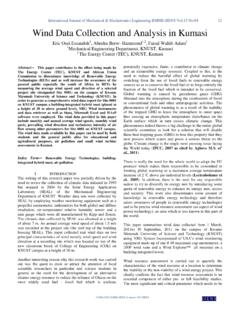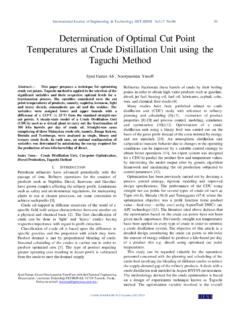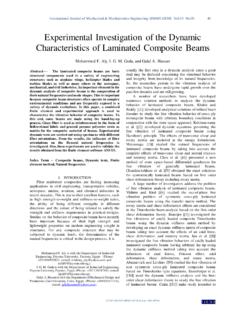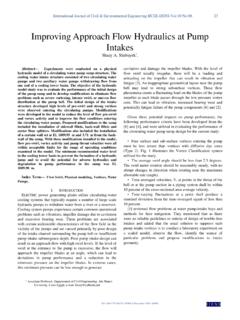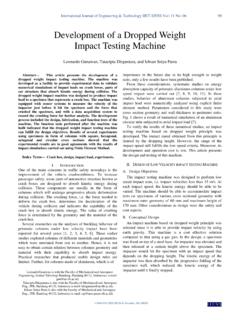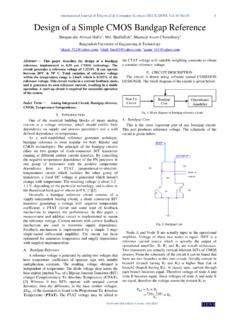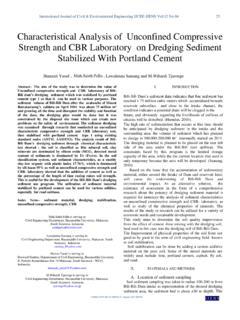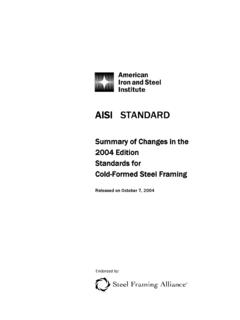Transcription of “Structural Behaviour of Steel Fabric Reinforced Concrete ...
1 International Journal of Civil & Environmental Engineering IJCEE-IJENS Vol:10 No:04 47 101704-9292-IJCEE-IJENS August 2010 IJENS I J E N S Structural Behaviour of Steel Fabric Reinforced Concrete Wall Panel Under Eccentric Loading Ir Ruzitah Supinyeh1, Ir Dr Siti Hawa Hamzah2 Civil Engr Student, Faculty of Civil Engineering, Universiti Teknologi MARA, 40450, Shah Alam.
2 Malaysia. 2 Professor, Faculty of Civil Engineering, Universiti Teknologi MARA, 40450 Shah Alam, Malaysia Abstract-- Recently Reinforced Concrete walls have gained greater acceptance from many countries in conjunction with the Industrialized Building S ystem (IBS ). Essentially, the system gives an advantage in reducing the dependency of foreign labour and a better investment in technologies, techniques and processes of construction. S teel Fabric Reinforced Concrete wall panel has been used in Malaysia in the past few years and can still be considered as a new construction method.
3 This type of wall may require sequential analysis in making an effective product that gives advantages in all aspects and gives better performance. This research involved laboratory experimental work and model by using a finite element computer program as comparison of the results. Laboratory works tested eight wall samples with size of x and thick. (Length:Height:Width). The wall samples Reinforced with double layer Steel Fabric size B7 and Concrete Grade 30. The wall panel tested under axial load with the eccentric t/6 or of wall thickness.
4 Variations of support condition include of t/6 with pinned or fixed imposed at the top and bottom of the wall panel. Experimental result shows due to eccentric loading that all of the wall panels failed in compression shear which the wall panels shown a single curvature pattern where it bends towards the rear side. There are no cracks seen on both front and rear surfaces of the wall panel unless it crushed at top and base of the wall. It is observed that the ultimate eccentric loads (Pult) of kN and maximum deflection obtained from the experimental works.
5 The computer analysis shows that the wall panel failed by compression. Higher stress concentration appears at the upper and bottom corner of the wall panel. The deflection obtained over by compared with the experimental results. Comparison with the experimental and the computer analysis results were found in good agreement. Index Term-- Concrete wall panel, Steel Fabric , eccentric INTRODUCTION A changed in structural design from moment-resisting to flexible frames with stiff shear resisting elements has occurred in recent years.
6 In Malaysia the changed starts in late 1990's when the Government Plan For Zero squatters in Kuala Lumpur. As such Steel tunnel formwork system or Tunnel form had been used in replacement of conventional sawn timber formwork. They are a number of generic forms of shear wall structure or Industrial Building System (IBS) named as Steel Tunnel Formwork System, Steel Shear Wall Climbing Formwork System and Steel Wall Panel System [1]. Shear wall offers efficient means of enclosing and utilizing space.
7 Thinner walls reduce the cost of buildings as well as increase the net lettable space of a building. Shear wall did not require column and beam as structural members. It can act as column and could transfer load from roof to foundation. A combination of pile and raft foundation is practically and economical design when the shear wall floor started at ground floor. Shear wall building is commonly built to consist 10 to 35 storey. This is the most suitable construction method to build apartment units in several blocks and within limited time frame.
8 The construction speed of the shear wall is normally controlled by the concreting and subsequent depropping of the floor slabs. Props should be left in place until the slab has achieved adequate strength to resist further propping and construction loads. Practically the thickness of wall is varies from 100mm to 225mm. Loads on wall are usually in plane axial loads and lateral load but often they could become accidental eccentric loads due to constructional imperfections also non uniform distribution of load on wall panel.
9 As the thickness of the wall panel is small and the wall is a slender element thus the analysis of wall panel shall include the considerations of the stability. Steel Fabric is widely used in reinforce shear wall. In the specification for Steel welded Fabric for the reinforcement of Concrete according to Malaysia Standard MS 145:2001 (Second Edition), the Steel strength is of grade 510 Steel [2]. The substitution of normal rebar to Steel Fabric expedites faster installation and considerable costs saving. EXPERIM ENTAL PROGRAM The experimental work involved testing of eight (8) wall panels with the specified material properties.
10 The material used has been confirmed earlier by conducting cube and Steel Fabric strength tests. The structural performance of the wall panel such as the ultimate strength load, mode of failure and cracking pattern will be determined. Eight wall panels Reinforced with double layer of Steel Fabric type B385 (B7) with a dimension of 75 mm thick (width) x 1000 mm long x 1500 mm high were prepared. For Steel Fabric type B7 the main and cross wire are 100mm and 200mm centre to centre spacing. The aspect ratio (h/L) is and the slenderness ratio International Journal of Civil & Environmental Engineering IJCEE-IJENS Vol:10 No:04 48 101704-9292-IJCEE-IJENS August 2010 IJENS I J E N S (h/t) is 20.
![IJENS-RPG [IJENS Researchers Promotion Group] ID: …](/cache/preview/1/7/b/a/8/0/e/3/thumb-17ba80e3168c7f59c03bc21e79d7d2ee.jpg)
